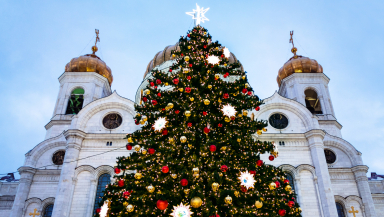
Across most of the Orthodox world, many millions of people celebrate Christmas on 7 January. This is the story...
Where Christmas is in December
For most Christians from a Catholic and Protestant tradition, Christmas falls each year on 25 December, where it is a public holiday across much of the world. However, there are some countries where Christmas Day public holiday falls on 7 January.
Where Christmas is in January
Christmas Day is a public holiday on 7 January in Eastern Europe in Belarus, Macedonia, Moldova, Montenegro, Serbia and Russia, as well as in Georgia and Kazakhstan. In north-east Africa, it is on 7 January in Egypt and Ethiopia, and in Armenia it is 6 January.
These are countries where the majority of Christians are from the Orthodox tradition. In some of these countries, all the Christians follow Orthodox Christmas. For example in Macedonia the Protestants, where there is a historic sizable Methodist minority, follow Christmas on 7<sup>th January like everyone else.
Christmas in Ukraine
Until 2023, Christmas Day was also marked on 7 January in the Ukraine. However for political and cultural reasons, in the same year, Ukraine switched celebrating Christmas from 7 January to 25 December, so the phrase 'Christmas comes but once a year' was not true in Ukraine last year.
Great Schism
The division between eastern and western Christianity is nearly a thousand years old. The Christian world broke into Eastern Orthodox Church and Western Catholic spheres at the Great Schism in 1054 AD. This following many centuries of tensions over cultural and theological differences, and different attitudes to authority. However, the Eastern and Western Christian worlds agreed that Christmas Day was on the same date on 25 December.
The Gregorian Calendar
It was in 1582 that the leader of the Roman Catholic Church, Pope Gregory XIII issued a decree, called a papal bull, which reformed the calendar. That year, in many Catholic countries, Thursday 4 October was followed by Friday, 15 October, with ten days skipped. Other European countries followed suit in 1582, 1583 or 1584.
The other small change was in the spacing of leap years. The old Julian calendar had a leap year every fourth year. However the Gregorian calendar had them in years divisible by four, except for those years divisible by 100, unless they are also divisible by 400. Thus years like 1900 and 1800 were not leap years but the year 2000 was.
Suspicion of the Pope and Catholicism meant that non-Catholic countries, in the Orthodox east, and the newer Protestant north, were wary of the change. Orthodox Christians do not recognise the authority of the Pope, and Protestant countries which had had their own Reformation to free themselves from papal power, were not inclined to do so either. For nearly two hundred years two different calendars were in use in western Europe.
Actually, the Pope's reason for changing the calendar were good. Dates of important Christian holidays had drifted away from the natural calendar. According to custom Easter, which was considered the Church's most important festival, should always fall around the spring equinox. Problems were occurring doing this with the Julian calendar, because the spring equinox was slowly moving out of synch with the natural year. Pope Gregory XIII convened a group of astronomers and proposed a new calendar, now known as the Gregorian calendar, which was named after him. It was a success and today the Gregorian calendar is the most internationally used civil calendar.
The Julian Calendar
The Roman calendar was introduced by Julius Caesar in 46 BC, and it is named after him and called the Julian calendar. This was a solar calendar, and was based on the work of Egyptian astronomer Sosigenes, because of the problems of using the lunar calendar. The problem is that the moon goes through just over twelve cycles, called months, in the time that the earth takes to rotate round the sun, called a year. Sosigenes' calculations were very good by the standards of the day, but he overestimated the length of the solar year by about 11 minutes. This became more noticable as the centuries progressed.
Adoption of the Gregorian Calendar by Protestants
Protestants slowly came to realise that the Gregorian calendar was not a Papal plot at all. Over the centuries, the calendar had slowly got out of synch with the seasons, so that it was wrong by ten days by 1582. Denmark and Norway adopted the Gregorian calendar in 1700, but Britain held out until 1752.
When Christmas moved in Britain
Great Britain, Ireland, and the American colonies did not adopt the new calendar until 1752, but which time the calendar was then out of synch by yet another day. That year, Wednesday, 2 September, was followed by Thursday, 14 September 1752, and eleven days were dropped. From that time, 7 January was known as 'Old Christmas Day'.
Christmas on Foula
One island in Scotland, the isle of Foula in the Shetland Isles, still uses the Julian calendar and holds Christmas according to the Julian calendar, which is 7 January in the Gregorian Calendar. Actually it is quite convenient because visiting priests who come to celebrate Christmas take some days to get there.
The Orthodox World
Although Catholic countries adopted the Gregorian calendar in the sixteenth century, and Protestant countries were using it by the eighteenth century, Orthodox countries continued to use the Julian calendar.
The Russian Empire continue to use the Julian calendar until it was changed to the Gregorian calendar by the communists on 14 February 1918, which is why the 'October Revolution' happened on 7 November 1918. The communists were anti-religious, and did not endear themselves to the Orthodox Church, which continued to use the Julian calendar, whilst the state of Russia itself used the Gregorian calendar. Other countries followed suit and Romania adopted the Gregorian calendar in 1919, Greece and Cyprus in 1923, and Turkey in 1926. When this happened, some of the Orthodox Churches also adopted the Gregorian calendar and some did not. So Christmas is on 25 December for the Orthodox in Romania and Greece, according to the Gregorian calendar.
However, the Georgian, Russian, Serbian, Macedonian, Coptic, Ethiopian and Syriac Orthodox Churches still hold Christmas Day according to the Julian calendar, which is 7 January in the Gregorian calendar. In these countries Orthodox Christians use the Gregorian calendar for daily life, but revert to the Julian calendar for ecclesiastical purposes and the festivals.
Ethiopian calendar
Actually it is even more complicated in Ethiopia, because there is a completely different calendar with thirteen months. The Ethiopian calendar has twelve lunar months each with thirty days, and then there is an extra intercalary month at the end of the year, with five or six days to get the lunar calendar in synch with the solar calendar. On top of that, the Ethiopian calendar year is seven years behind the western calendar.
One Christmas Day, two calendars
So, it is not that Christmas Day is held on a different day. In the Catholic, Orthodox and Protestant traditions it is held on 25 December, it is just that the Orthodox calendar uses the Julian calendar and 25 December in the Julian calendar, falls on 7 January in the Gregorian calendar. So the different Christmas Days are not a disagreement about when the birth of Jesus actually happened, as is sometimes reported, but it is just a matter of which calendar is used. As we don't actually know the actual day that Jesus was born on, it does not matter very much which day is used to remember it.













